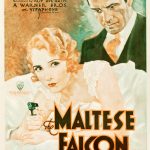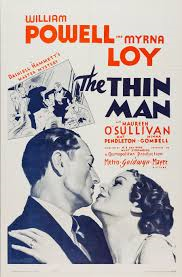The Golden Age of Mystery refers to the period between World War I and World War II. In America, writers created the hard-boiled detective. They portrayed the detective, a male, usually as a loner, facing the violence and nihilism of the post-WWI world. Often cynical, tough, hard-boiled, they lived with an internal code of right and wrong. Unlike the English detective, the American private eye is from the common people. They don’t use their great minds to solve puzzles. Instead, they use hard work and a willingness to get dirty to catch their criminal, or not.
This hard-boiled detective fiction is also called noir. Because of the time period, I always think of the films as being in black-and-white.
Although Dashiell Hammett only wrote five novels, he is known as one of the pioneers of detective fiction. He brought us Sam Spade, Nick and Nora Charles, and the Continental Op. Many of the best-selling mystery writers, including Raymond Chandler, say that they were influenced by his style and stories.
Biography
The New York Times called Dashiell Hammett “the dean of the hard-boiled school of detective fiction” by in his obituary in 1961. His Continental Op was one of the first fictional detectives and was the first to give the cynical, independent mindset that became popular with the genre. His detectives set the standard for the fictional private eye in the US in the period between the world wars.
Born in 1894, Samuel Dashiell Hammett was raised on a farm in rural Maryland. He went by Sam in his earlier years. At thirteen, his father pulled him out of school so he could find a job and help provide for the family. Later, he made up for his lack of education by reading broadly.
In 1915, he began working with the Pinkerton National Detective Agency. At one time, Pinkerton was the largest law enforcement agency. They came to fame when they protected Abraham Lincoln as he ran for president. Hammett used his experiences to make his writing and characters more realistic.
He enlisted in the United States Army in 1918. Most of his first year was spent in the Army hospital after coming down with the Spanish flu. His flu brought about tuberculosis, which effected his health the rest of his life. A year after enlisting, the army discharged him and returned to Pinkerton’s in Spokane, Washington. While recuperating in a hospital, he met his first wife, Josephine Dolan.
Hammett’s first short story was published in the magazine, The Smart Set, in 1922. His first novel, Red Harvest, came out in 1929, after being serialized in the magazine, The Black Mask. Time Magazine included this book in its list of the 100 Best English-language Novels published between 1923 to 2005.
Red Harvest included Hammett’s earliest hero, the Continental Op. The Op, who never gave his name, narrated the stories and worked for a fictionalized PI agency in San Francisco. Hammett later said he used combination of the agents he worked with to create him.
From September 1929 through January 1930, the stories that later became The Maltese Falcon first ran in The Black Mask. Many considered this to be his best work. The Mystery Writers of Americat voted it number 2 in The Top Mystery Novels of All Time. It introduced us to Sam Spade, one of the world’s most famous private eyes.
In 1926, his first wife had their second daughter. Because of his tuberculosis, health services told his wife that he shouldn’t live with them full time. She moved into a rented house in San Francisco and he would visit on the weekends. The marriage soon fell apart. He continued to financially support his children and their mother while his writing lasted.
In 1931, Hammett began a thirty-year relationship with playwright, Lillian Hellman. They alternated between New York and Hollywood, where he wrote screenplays for films and his books were turned into films. She was with him later when he died of lung cancer in 1961.
In 1934, Hammett wrote his last novel, The Thin Man.
While Hellman’s screenwriting career took off, his declined. In the forties, Hammett and Hellman lived on her farm, Hardscrabble Farm, in Pleasantville, NY.
In 1942, after Pearl Harbor, Hammett enlisted in the Army. He had to get an exception because of his age and his membership in the American Communist Party. He served in the Aleutian Islands before becoming an editor with The Adakian, an Army newspaper.
The couple became involved with the American Communist Party, which ultimately caused Hammett to spend five months in prison. He also became an alcoholic and continued to suffer from tuberculosis.
Writing
Hammett lived in San Francisco while he wrote in the twenties. Critics believed this was why his descriptions of the city and its citizens were so realistic. He drew on the people he had encountered as he worked with Pinkerton. He was one of the first writers to use dialogue that sounded authentic to the setting.
Raymond Chandler, another of the legendary writers of detective fiction, compared Hammett’s writing style to Hemingway’s. “He was spare, frugal, hard-boiled, but he did over and over again what only the best writers can do at all. He wrote scenes that seemed never to have been written before.”
Why Hammett moved away from fiction is unknown. Hellman wrote in one of his collections published posthumously, “I think, but I only think, I know a few of the reasons he wanted to do a new kind of work; he was sick for many of those years and getting sicker.” He was also busy helping Hellman with her plays and defending himself against accusations of communist sympathies.
Main Characters

Dashiell Hammett succeeded in doing what few writers have been able to do, give us readers not one iconic hero but three. The first was the unnamed Continental Op. Based in San Francisco, this narrator worked for a detective agency.A war hardened character, he feared becoming even less caring than his boss back at headquarters.Hammett said, “I do take most of my characters from real life.”
In The Maltese Falcon, Hammett introduced us to Sam Spade. Humphrey Bogart’s portrayal made the detective alive to u, although he differed from the “blond devil’ as he was described in the novel. Bogart gave him a swagger and a remoteness that fitted the character.
Hammett said of Spade, “Spade has no original. He is a dream man in the sense that he is what most of the private detective I worked with would like to have been and, in their cockier moments, thought they approached. For your private detective does not—or did not ten years ago when he was my colleague—want to be an erudite solver of riddle in the Sherlock Holmes manner; he wants to be a hard and shifty fellow, able to take care of himself in any situation, able to get the best of anybody he comes in contact with, whether criminal, innocent bystander, or client.”
As Daryl Sparkes said in The Conversationalist, “You’ll be glad to have him on your side, and terrified to have him as your opponent.”

In The Thin Man, we meet the hilarious newlyweds, Nick and Nora Charles. Nora was based on Lillian Hellman. To me, these movies have become part of the holiday tradition.
The booze, the smoking, the excessiveness, the joy of living, all harken back to the Roaring Twenties before the Depression hit. It’s great to see a married couple portrayed with so much humor and love for each other. We’ve seen so many times where the writers believed that marriage was the death of romance and popularity in a series in books or on TV.
Nick was a police detective who married the rich Nora. They were free to travel and enjoy life. But something always seemed to pop up. And Nora seemed to always be game to try her own investigating skills.
Their playfulness and banter gave comic relief to the investigations. Their dog, Asta, stole many of the scenes.
The book reads largely like the movie with a few places where censors had them make changes. The couple were popular enough to run for six films.
A list of Hammett’s writings and films can be found here.
One response to “Dashiell Hammett”
[…] Dashiell Hammett may have been the first mystery author to make the dog a family pet and give it a larger role in the story. In his Thin Man series, Asta, an Airedale in the book but a wire fox terrier in the movies, sometimes stole the scene, especially in the movies that I love so much. […]